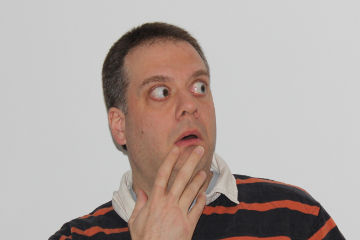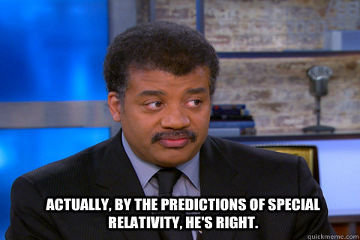What I’ve Learned:
“Special relativity: out with the aether, in with the aother.”
On the heels of the holiday season, you may have recently witnessed instances of “special relativity”. Grandma’s secret-recipe fruitcake pucks. Your uncle’s uncomfortably falsetto rendition of “O Holy Night”. Cousin Lem’s drunken faceplant into a bowl of Christmas bisque.
Happily, that’s not the only sort of special relativity. One hundred and ten years ago, Albert Einstein (with a little help from his friends) developed a theory that explained the behavior of things that travel near the speed of light. Like New York City taxis, or Usain Bolt. Or, you know, light.
This theory was needed because by the late 1800s, scientists had figured out that their plain old regular-speed relativity — based on work by Galileo and Newton, among others — wasn’t always getting the job done. This old school theory, called Newtonian relativity or Galilean invariance, because see the previous sentence, sport, said there is an “absolute space” and an “absolute time”, in which everything happens. And by that time, it also included an “absolute reference frame”, a universally unique point of view from which electromagnetic wave properties like the speed of light could be accurately measured.
Problem was, experiments suggested that if that uniquely-accurate reference frame (known as the “aether”) existed, all measurements made in labs were consistently in agreement with it. In other words, all those labs were stationary with respect to this spatial frame of reference. Which would be super, if we didn’t know that the Earth is constantly swooping around the sun (and the sun around the Milky Way, and the Milky Way hurtling through the universe), so it’s not really “stationary” compared to anything but itself.
Einstein dropped this “aether” concept down the nearest aelevator shaft, and that was just the beginning. He also decided that space and time were two great tastes that taste greater together, and mushed them together into something called “spacetime”. And he said no matter how fast you’re going (or not), the speed of light will always look the same. That let a whole bunch of crazy — but later experimentally verified — cats out of the physics bag. For instance:
Under special relativity, two people moving at different speeds may watch the same event happen, but observe it occurring at different times. And not just because one of them has TiVo, either.
If you watch two clocks — one moving and one sitting still — the moving clock appear to go slower. (And if it’s moving while you’re sitting in your office at ten minutes til five on a Friday afternoon, it’ll appear to go reeeeeeeeally slow.)
Mass and energy are equivalent, as given in Einstein’s famous special relativistic equation, E = mc2. This is obvious to anyone who’s eaten a four-ounce chocolate eclair and felt the kajillion-calorie jolt to their metabolism as the mass is converted to energy… and then seen six pounds of flab appear on their ass as it converts back to mass.
(I don’t know why it gets bigger in the conversion. What am I, some wild-haired German genius math guy?)
Basically, Einstein’s special relativity theory made some predictions crazier than drunk old Cousin Lem on an eggnog bender, but they turned out to be true where Newtonian relativity did not. Either theory will get you through the day for normal stuff — but if you’re zooming around near the speed of light, then you’d damned well better listen to Einstein.
He may not be your relative. But believe me — he’s special.



